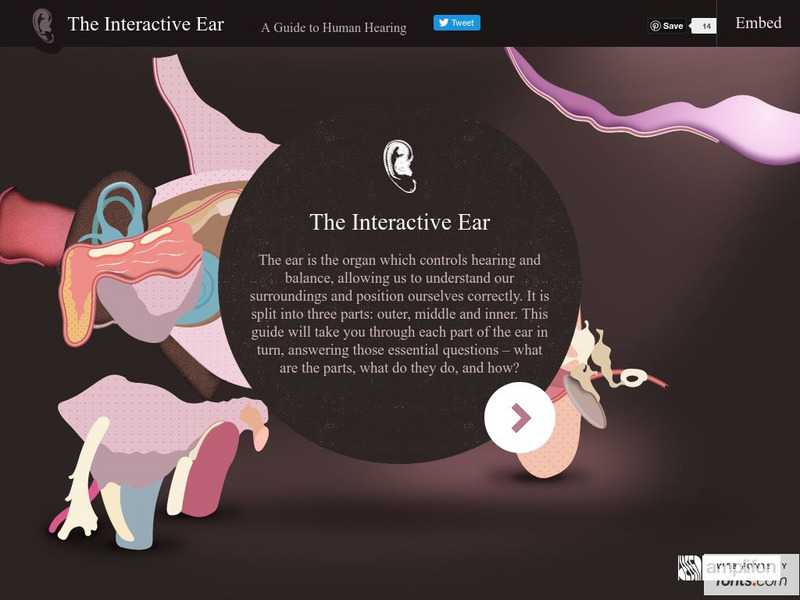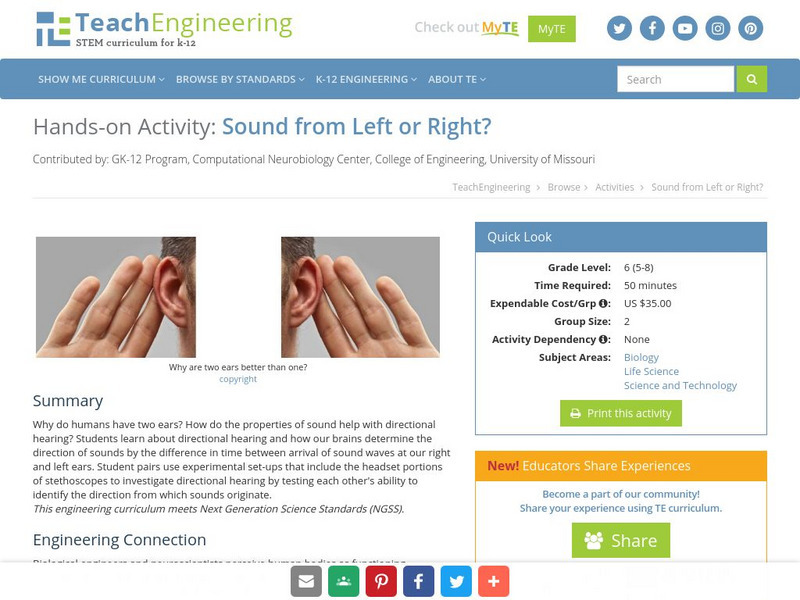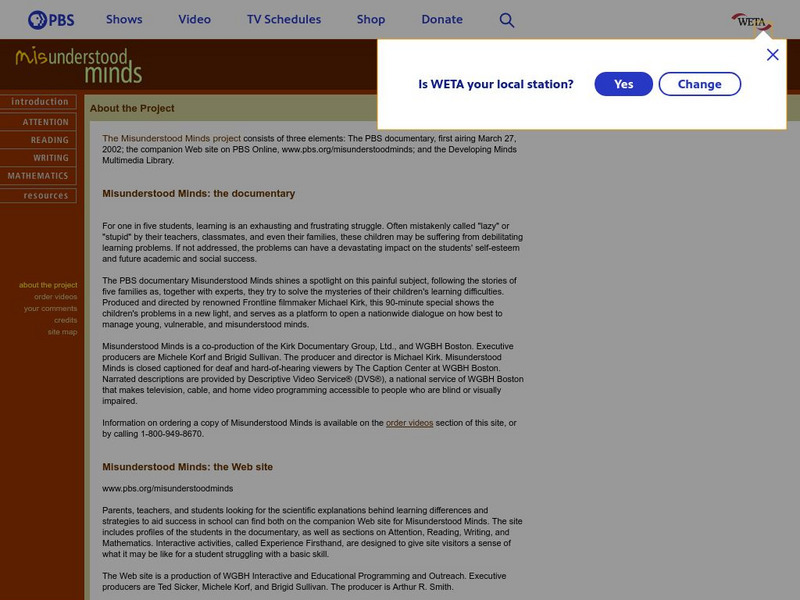Hi, what do you want to do?
Aetna Intelihealth
Aetna: Inteli Health: How the Five Senses Change With Age
This article discusses the link between anatomical changes related to aging and sensory loss. Delves into the problems associated with each of the five senses.
Curated OER
Kids Health: Hearing [Pdf]
We deal with loud noises in our environment all the time - some we can control and some we can't. Noise-induced hearing loss (NIHL) can be a problem for kids and teens, especially with the prevalence of earbuds and handheld devices that...
Other
Huffington Post: How to Listen to Music Without Destroying Your Hearing
This article provides statistics and other information about hearing loss, especially due to listening to loud music with headphones or earbuds. It also focuses on how to prevent hearing loss caused by listening to music. This...
Other
Amplifon: Interactive Ear: A Guide to Human Hearing
The Interactive Ear is a whole ear model which allows the user to explore all the inner-workings of the human ear.
PBS
Pbs Learning Media: Moriussaq: A Case Study in Hearing Loss
This video segment follows neurophysiologist Allen Counter as he studies an epidemic of hearing loss in Moriussaq, Greenland, one of the quietest places on Earth. Footage from NOVA: "Mystery of the Senses: Hearing."
Curated OER
Web Gallery of Art: The Senses of Hearing, Touch and Taste
An image of "The Senses of Hearing, Touch and Taste", created by Jan the Elder Brueghel in 1618 (Oil on panel, 176 x 264 cm).
Curated OER
Web Gallery of Art: The Sense of Hearing
An image of "The Sense of Hearing", created by Jan the Elder Brueghel in 1618 (Oil on panel, 65 x 107 cm).
CK-12 Foundation
Ck 12: Life Science: 11.50 Hearing and Balance
Understand the human sense of hearing and how it relates to balance.
WebMD
Medicine Net: Hearing and Balance Anatomy
Learn all about the ear and how it works in this illustrated article on the anatomy and function of the ear.
Frontiers Media
Frontiers: Seeing With Your Ears: A Wondrous Journey Across the Senses
For dozens of years it has been believed that the brain is organized into "sensory areas": that is, that there is a "visual area," an "auditory area," and so forth, and that the visual area can only process visual information. It has...
Georgia Department of Education
Ga Virtual Learning: Anatomy and Physiology: Senses
Through informational text with printable notes, animations, video clips, and practice problems students discover the function of the sensory structures in the human body.
TeachEngineering
Teach Engineering: Sound From Left or Right?
Why do humans have two ears? How do the properties of sound help with directional hearing? Students learn about directional hearing and how our brains determine the direction of sounds by the difference in time between arrival of sound...
TeachEngineering
Teach Engineering: Hearing: How Do Our Ears Work?
Students learn about the anatomy of the ear and how the ears work as a sound sensor. Ear anatomy parts and structures are explained in detail, as well as how sound is transmitted mechanically and then electrically through them to the...
Science Education Resource Center at Carleton College
Serc: Listening Challenge With Your Ears
For this activity, students will be able to use their sense of hearing to figure out which film containers sound the same and contain the same substance. They will then match their containers and self-check their answers.
National Institutes of Health
National Library of Medicine: Using Our Senses
This lesson plan site delves into the senses of smell, touch, taste, sight, and hearing. Students will be able to describe the ways senses affect their lives and how a pediatrician uses his/her senses to examine patients.
The Franklin Institute
The Franklin Institute Online: Coming to Our Senses
Help students make "Sense," of their senses by using them in the classroom. Site provides discovery activities students can do on themselves, in their classrooms and around campus. A scavenger hunt is also provided.
Curated OER
Kids Health: Taking Care of Your Ears
An informative site that deals with the parts of the ear and their functions. Text is complemented with pictures.
Alabama Learning Exchange
Alex: Using a Fairy Tale to Teach the Elements of a Story
Students will hear and read different versions of a familiar fairy tale and identify what elements a story must have (character, plot, setting) for the story to be interesting and make sense. Using a Venn diagram, students will then...
Scholastic
Scholastic Instructor: Science of Sound
This resource is for teachers who are looking for information, activities, experiments, and more pertaining to the science of sound.
Science and Mathematics Initiative for Learning Enhancement (SMILE)
Smile: Introduction to the Senses
This lesson plan allows students to investigate body parts associated with each of the five senses.
SEDL
Sedl: Five Senses
Elementary students will gain great insight into the workings of our five senses through this collection of detailed, integrated lesson plans for grades K-3. Each lesson contains a list of needed materials, hands-on explorations...
PBS
Pbs: Misunderstood Minds
A wonderful spotlight on scientific explanations behind learning differences and strategies to aid success in school. Includes profiles of the students in the documentary as well as interactive activities designed to give site visitors a...
eSchool Today
E School Today: Your Revision Notes on the Five Senses
Learn how the sense organs are structured and how they function to provide you with five senses.
PBS
Pbs Teachers: Scientific American: The Art of Science: Ben Franklin's Harmonica
Investigate the science behind the glass harmonica, and try Ben Franklin's version. Explore the world of sound with hearing and other senses, and find out how different length straws influence sound by modifying frequency.





















